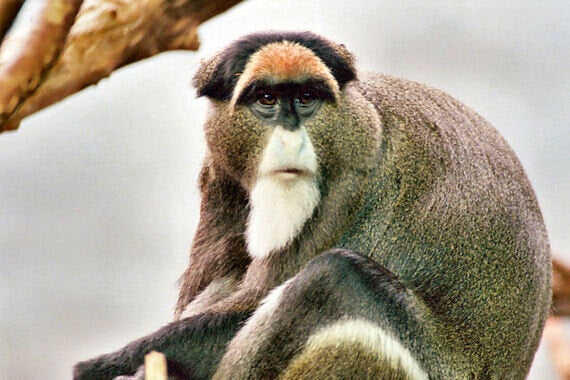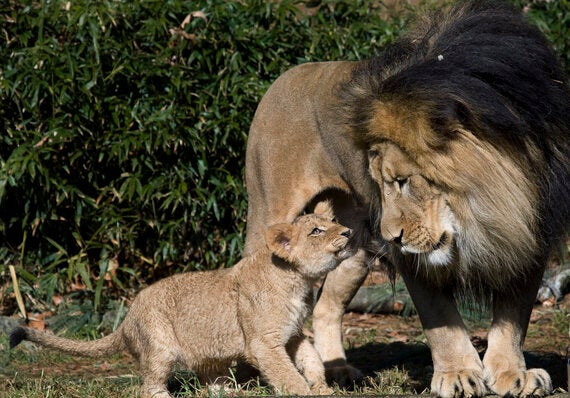Verbal communication in humans is 60% affected by the way your face looks. So what does that tell us about the new hipster trend to grow full on beards? Distinctive facial hair such as moustaches, bushy eyebrows and beards have first evolved in primates to help them easily recognise each other in forest environments.
Guenon monkeys for example sport all kinds of quirky colourful facial hair in both males and females, each of the 24 plus different species have their own distinctive facial masks.

Photo by leamaimone/flickr
Scientists have tried to uncover why evolution selected those traits. The Eigenface computer facial recognition algorithm developed in the 1980s was used to guess individuals, age, gender and species in photographs. It turns out, based on facial hair, the computer couldn't make the difference between males and females, or decide how old an individual was. It could however, very clearly decide the species and tell which individual was in the picture.
Scientist speculate that if you live in a stable social group and you can recognise an individual, then you can associate gender and age to them, you don't need the face to give you that kind of information. However, when you live high in rainforest canopies with other closely related species, what you do need to recognise is your own kind, for breeding and other social purposes.
Could Hipsters be trying to stand out in the city jungle as a different species?
Well, probably not. While the monkeys studied have males and females that look nearly identical to the human eye, it is usually easy to tell the difference between human men and women - especially when there is a beard in the picture. Facial hair in our case has taken on a sexier function.
In humans, moustaches and beards are what we call sexually dimorphic traits - they are only present in one sex. They probably play a role in sexual selection and in competition between same sex individuals. So think a little less like a monkey's ear tuffs and a little more like a lion's mane. Now don't get too carried away, although certain studies indicate that facial hair in men protect sensitive areas of the face during fist fights - which is one reason boxers have to be clean-shaven - it is unlikely a human beard has the same impact as the lion's protective and dense mane.

Photo by nationalzoo/flickr
Many studies have shown that women link beards to masculine traits and the signalling of high testosterone levels. Bearded men are rated more dominant, more masculine, more trustworthy, more protective, having better parenting abilities and seemingly more healthy.
But beards are not all positive as other studies have also shown bearded men as being more aggressive, 38% less generous, 36% less caring and 51% less cheerful. But despite that, as Darwin - that long bearded bald guy - once put it, beards evolved on our ancestors because of female choice, because it made men look more masculine and more attractive.
That was until an Australian team announced at the beginning of 2014 that beards had reached peak frequency. Beards were too common. Following bearded Darwin's idea of 'negative frequency-dependant sexual selection' - the more a trait is rare, the more it is desirable - hipsters had come to a beard saturation limit - and this made them less attractive.
Facial hair trends have come and gone across human evolution - sexy sideburns quickly moved on to handle-bar moustaches in the 70s, to magnum pi moustaches in the 80s and to clean shaven men in the 90s. Lately, the bushy beards were back - the 10 day bristle being the most popular. Prof Rob Brooks even suggests that the financial crisis of 2008 might be responsible for the recent boom in hipster beards, with young men needing to boost their masculinity to attract someone when work isn't easy to come by. Similarly, after the 1920s' Wall Street crash, there is evidence that beards got big again. So hipster might just be the creation of poor economic circumstance and young unemployed men trying to get attention.
So what about the poor men that can't seem to grow a full beard, are they destined to stay job-less and women-less? Luckily for them, beards are actually not linked to levels of masculinity and testosterone - they are more linked to their genes. Their facial hair follicles are just less sensitive to testosterone derivatives, and therefore don't grow as much. However, cheer up, if you have less facial hair, you are probably not going to go bald either.
Overall if there is one advice I can give men - hipsters or not - concerning their facial hair, is to never go for the goatee. According to science it is the riskiest facial hair arrangement that a man can choose. People tend to associate a shape of a goatee with evil -something about the downwards facing triangle just creeps people out.